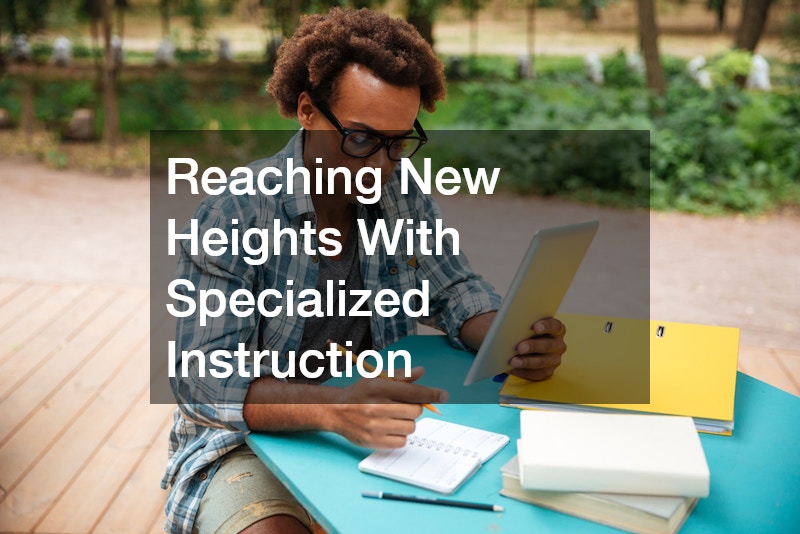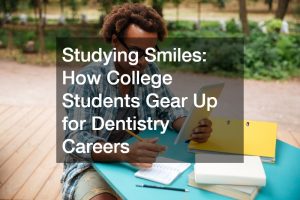Education has always been the foundation of personal and professional growth, but the way we approach learning has evolved significantly in recent years. Modern academic settings now combine traditional instruction with specialized programs, creating opportunities that prepare students for both immediate success and long-term goals. These environments are no longer limited to classroom-based education; instead, they extend to career-focused training, skill development programs, and hands-on experiences that reflect real-world demands. As families and individuals seek out the right path, understanding what modern education has to offer becomes increasingly important.
Modern academic settings today place a strong emphasis on balance, ensuring that students have access to foundational learning as well as advanced training opportunities. From early education that establishes critical thinking skills to specialized programs that prepare students for unique career paths, the range of options continues to grow. The goal of these diverse learning environments is not only to impart knowledge but also to cultivate confidence, adaptability, and lifelong curiosity. By exploring the different programs available, it becomes clear how education is shaping future generations to succeed in a wide range of fields.

- Exploring Career Opportunities in Creative Industries
- Building Strong Foundations in Early Education

- Preparing Young Learners for Lifelong Success
- Gaining Practical Skills Through Technical Training

- Reaching New Heights With Specialized Instruction
- Learning Professional Grooming in Hands-On Programs

- Developing Confidence and Safety in Physical Education
- Designing Environments That Support Student Growth
- Maintaining Safe and Healthy Learning Spaces
- Advancing Professional Skills With Specialized Programs
Exploring Career Opportunities in Creative Industries
Modern education settings have expanded far beyond the boundaries of traditional academics to include career-driven training in creative industries. Academic settings that focus on artistic expression, technical skills, and client-centered services allow students to pursue passions while developing practical expertise. These programs highlight the importance of combining creativity with professionalism, ensuring that learners graduate with the tools needed to thrive in competitive markets. By introducing career-specific pathways, academic institutions are helping students transform personal interests into long-term opportunities.
In a more specific sense, programs in cosmetology demonstrate how creativity and technical training can blend seamlessly within modern academic settings. Students in these programs learn not only about styling and aesthetics but also about customer service, business management, and industry standards. The hands-on approach prepares graduates to step confidently into salons, spas, or even entrepreneurial ventures. By integrating professional skill-building with artistic exploration, cosmetology programs showcase the value of education that connects classroom learning with real-world application.
Building Strong Foundations in Early Education
At the heart of every successful learning journey is a strong educational foundation, which begins in the earliest years. Academic settings designed for young children place emphasis on nurturing curiosity, encouraging social development, and building essential skills that set the stage for future success. These environments focus on more than just academics; they also prioritize emotional growth and collaboration, helping children develop confidence and independence. By investing in early education, families provide children with the tools they need to thrive in later academic stages.
Looking more closely, private preschools highlight the benefits of individualized instruction and smaller class sizes. These settings often provide enriched curriculums that incorporate language development, problem-solving, and interactive learning experiences tailored to each child. Teachers in private preschools are able to adapt to unique learning styles and foster an environment where students feel valued and supported. This approach shows how academic settings in early childhood education can provide a meaningful head start, preparing children not just for school, but for lifelong learning.
Preparing Young Learners for Lifelong Success
Modern cademic settings for early learners play a critical role in shaping future educational outcomes. By introducing structured activities, social interaction, and foundational skills, these programs ensure that children are well-prepared to transition into higher levels of schooling. A strong start at this stage builds confidence and fosters a love of learning that can carry throughout a child’s academic journey. Families often look for environments that blend play with instruction, as these balanced approaches promote both intellectual and emotional growth.
In practice, the best kindergarten programs provide a supportive and engaging environment where children can develop literacy, numeracy, and problem-solving skills. These classrooms often emphasize interactive learning, where young students explore through hands-on activities and group collaboration. Teachers play a central role in guiding curiosity while also setting expectations for behavior, responsibility, and teamwork. By combining structure with creativity, the best kindergarten programs show how academic settings can create a solid bridge between early childhood education and formal schooling.
Gaining Practical Skills Through Technical Training
While traditional education lays a strong foundation, technical training opens doors to specific career opportunities. Academic settings that provide hands-on instruction in trades and applied sciences equip students with practical knowledge that can lead directly to employment. These programs highlight the importance of experiential learning, where theory is paired with real-world application. By offering technical training, schools ensure that education is accessible and relevant to those who prefer skill-based career paths.
Specifically, welding classes training demonstrates the value of vocational education within modern academic settings. These programs teach essential skills such as metal fabrication, blueprint reading, and safety protocols. Students often work directly with tools and equipment, gaining confidence through practice. Graduates of welding programs are well-prepared to enter industries ranging from construction to manufacturing. This type of training shows how technical education provides not only career readiness but also the potential for long-term stability and growth.
Reaching New Heights With Specialized Instruction
Education is not limited to the classroom; in many cases, it takes place in highly specialized environments designed to meet unique career goals. Modern academic settings that focus on advanced instruction push students to explore areas of interest that require precision, discipline, and dedication. These opportunities are ideal for individuals who are motivated to pursue fields that demand specialized training and certification. Such programs prove that education can be both inspiring and highly practical.
For example, flight schools offer an exceptional blend of technical expertise and real-world application. Students in these programs learn not only how to operate aircraft but also how to understand navigation, meteorology, and aviation safety standards. The training is rigorous and requires commitment, but it opens doors to rewarding careers in aviation. Flight schools illustrate how specialized modern academic settings can transform passion into a profession by providing clear pathways to certification and employment in competitive industries.
Learning Professional Grooming in Hands-On Programs
Career-focused education thrives in environments where students can practice skills in real-world scenarios. Academic settings that emphasize hands-on training give learners the opportunity to apply knowledge directly, preparing them for careers that require precision, confidence, and technical ability. These programs not only teach a trade but also encourage professionalism, client communication, and adaptability. By combining theory with practice, they ensure that graduates leave with the tools to succeed immediately in the workforce.
A clear example of this approach is found in local barber schools, where students learn the art and science of grooming. Beyond haircutting and shaving, these programs cover sanitation practices, customer service, and the business aspects of operating a barber shop. Students gain experience by working directly with clients in supervised environments, allowing them to build confidence and refine their skills. In this way, local barber schools demonstrate how academic settings focused on vocational training prepare individuals for careers that balance creativity, tradition, and entrepreneurship.
Developing Confidence and Safety in Physical Education
Education is not limited to academic knowledge—it also encompasses physical development, personal safety, and confidence-building. Academic settings that incorporate physical education programs highlight the importance of balance, ensuring that students develop both mental and physical well-being. Activities such as sports, structured play, and fitness instruction teach teamwork, discipline, and perseverance, all of which are essential life skills. By integrating physical development into learning, schools create well-rounded individuals prepared for challenges both inside and outside the classroom.
Swim lessons are an excellent example of how physical education is woven into academic settings to promote safety and skill development. These programs not only teach the technical aspects of swimming but also focus on building confidence in the water and fostering lifelong fitness habits. Instructors ensure that students progress at their own pace while emphasizing essential safety practices. Including swim lessons as part of an educational journey demonstrates how academic institutions address the holistic needs of students, prioritizing health, safety, and personal growth alongside traditional learning.
Designing Environments That Support Student Growth
The physical environment in which learning takes place has a profound effect on student success. Academic settings that prioritize well-designed spaces create conditions where students feel motivated, supported, and inspired to learn. Factors such as natural lighting, classroom layout, and access to resources all influence focus, collaboration, and overall performance. By viewing the building itself as part of the educational process, institutions reinforce the idea that the environment is just as important as the curriculum.
An educational building designed with student needs in mind provides spaces that encourage creativity, collaboration, and exploration. Modern schools often incorporate flexible classrooms, advanced technology, and safe common areas where students can engage with both peers and instructors. These facilities are also built with sustainability and accessibility in mind, ensuring that they meet the needs of diverse learners. Including a focus on educational building design within academic settings demonstrates how infrastructure directly contributes to student achievement and long-term satisfaction with the learning experience.
Maintaining Safe and Healthy Learning Spaces
Behind every successful learning environment is a commitment to safety, cleanliness, and overall well-being. Academic settings that prioritize hygiene and maintenance create conditions where students and staff can focus fully on education without unnecessary distractions. Clean schools help reduce the spread of illness, improve air quality, and contribute to a more welcoming atmosphere. Families and communities often evaluate institutions not only on the quality of instruction but also on the condition of the environment, making cleanliness a key component of trust and reputation.
School cleaning services provide the structure and consistency needed to keep educational spaces in excellent condition. Professionals in this field handle everything from daily sanitation of classrooms and common areas to specialized cleaning of laboratories, gyms, and cafeterias. Their work ensures compliance with health and safety standards while also promoting student comfort. By including the role of school cleaning services in discussions of academic settings, it becomes clear that the learning environment extends beyond instruction—it includes every detail that contributes to safety, focus, and long-term success.
Advancing Professional Skills With Specialized Programs
As education continues to expand, specialized training has become an important part of preparing professionals for emerging industries. Academic settings now incorporate advanced programs that go beyond traditional schooling to focus on highly specific skills. These opportunities attract individuals who want to refine expertise in niche fields and remain competitive in specialized markets. The availability of such training underscores how modern education is flexible, adaptable, and responsive to evolving career demands.
A notable example of this is the PDO thread training service, which equips professionals in aesthetics and wellness with the technical skills needed for advanced procedures. These programs combine classroom instruction with hands-on practice, ensuring that participants understand both the theory and application of their work. Training services like these also cover safety standards, client communication, and the legal aspects of offering specialized treatments. Including programs such as the PDO thread training service in academic settings shows how education adapts to meet professional needs, offering opportunities that are both practical and cutting-edge.
Education is no longer confined to a single path or limited to traditional classrooms. Instead, modern academic settings have evolved into dynamic environments that address every stage of personal and professional growth. From private preschools that nurture early curiosity to best kindergarten programs that prepare children for future success, early education lays the foundation for lifelong learning. As students grow, opportunities expand into technical training, such as welding classes, and specialized instruction, such as flight schools and barber programs, which turn practical skills into thriving careers. These diverse offerings demonstrate the wide scope of education and how it touches nearly every aspect of life.
Academic settings also emphasize balance by including physical development programs like swim lessons and infrastructure improvements through educational building design. The attention to detail extends beyond teaching to the maintenance of the environment itself, where school cleaning services ensure that classrooms remain safe, healthy, and conducive to learning. At the same time, the rise of advanced services like PDO thread training reflects the adaptability of modern education in meeting the needs of evolving industries. These examples reveal how education is no longer just about knowledge acquisition—it is about shaping environments and programs that align with individual aspirations and global trends.
Ultimately, the key theme running through all aspects of modern academic settings is their ability to prepare individuals for a variety of futures. They create pathways for children, support vocational opportunities for young adults, and provide specialized training for professionals seeking to refine their expertise. By embracing diversity in learning, these settings help students and professionals build confidence, resilience, and adaptability. In doing so, they not only support individual success but also strengthen communities by producing skilled, well-rounded, and forward-thinking members of society. Education in the modern era is expansive, inclusive, and essential—helping every learner reach their full potential at every stage of life.



